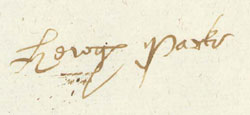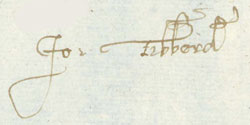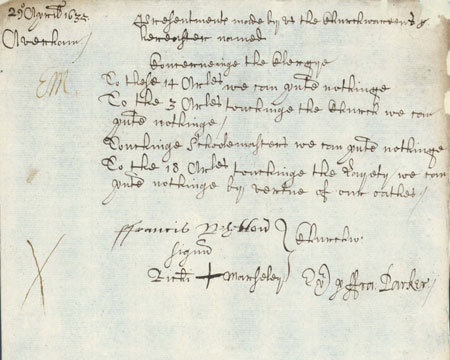Content and format
In general, Presentment Bills changed little over time. The type of information usually contained within Presentment Bills is as follows:
The date the bill was written and sent in to the court. From the early 1620s, this was normally the exact date of the visitation by the Archdeacon or his Official, at which the bills were written out and the churchwardens asked to swear an oath as to their accuracy. The visitations occurred in April or May (Easter term), and again in September or October (Michaelmas term), and were usually held at St Peter's church in Nottingham for parishes in the deaneries of Nottingham and Bingham, in the parish church of East Retford for parishes in Retford deanery and the parish church of Newark for parishes in Newark deanery.
The name of the parish or chapelry whose churchwardens were making the presentment.
Answers to Articles issued in advance by the Archdeacon, concerning the state of the fabric of the church, the conduct of the clergy, and the conduct of the laity. Clergy and churchwardens were called to the court by the use of Processes (some survive in the Citations series, AN/C), and either presented their already-completed bill, or answered each of the Articles read out by a court official, who then wrote out the Presentment Bill for them. The names of any parishioners who had offended against any of the Articles, and an indication of their offence, are given.
Names, signatures or marks of the churchwardens, sidesmen or 'jurati' (swornmen) who made the presentment. The Presentment Bills at the Easter visitation were usually produced by the churchwardens for the previous year - new churchwardens had just been sworn in at the Easter visitation and their names are often given, but they did not usually sign or mark the document. Some bills were produced or signed by the clergy in addition to, or instead of, the churchwardens, especially bills which were sent to the court at times other than at the official visitation.
Annotations relating to action taken on the presentments
Some (not all) of the presentments were considered worthy of further investigation. The first stage in any action against the presentee was to cite them to appear in court to answer the charge against them.
When citations were issued, a note to this effect was often added to the Presentment Bill, either written at the bottom of the page, or written against or above the name of the person involved. Until 1733, all such annotations were in Latin.
The annotations are often in the form:
- 'emanavit citacion in 20 Septembris 1634' = 'a citation was issued on 20 September 1634'. This is often abbreviated to 'emt' or 'emat'.
Other variants include:
-
'dimissit' = 'dismissed'
- 'comparuit in (date)' = 's/he appeared (in court) on (date)'
- 'expeditur eodem die' or 'expr (name) 16 maij' = 'let him be freed on the same day/16 May'
Image and transcription of a typical Presentment Bill
Date
the xxijth daye of Aprill Anno Dom 1613
22 April 1613
Annotations
em[anavi]t in ult[imo] Maij
Citation issued the last day of May
Content
Wee the Churchwardens do present such offenders as followeth
Item wee [present] all the Papestes [papists] Mistress Vawse and her servants for the same Robart Knote [and] Anne fisher for suspicion of fornication
Christofer Vell the wife of Thomas Lyllay for a Recusant
Edward Guntharpe for Standinge Excommunicate fortie dayes & more
Churchwardens' names
Henrye Shakellton
(made his mark)
George Danell
(made his mark)
Presentment Bill for Thorney, Nottinghamshire (AN/PB 295/4/127)
Court officials' names
Other people beyond the clergy and churchwardens were involved with the processing of the Presentment Bills and added their signatures or initials.
The earliest bills, from 1587 and 1589 (AN/PB 292/1 and AN/PB 292/2), survive in the form of transcriptions. They are written in the hand of Edward Copinger, who first appears examining Presentment Bills in 1610, and was Deputy Registrar of the Archdeaconry from 1625 to 1626. Written at the end of each parish's bill are the names of various people, some of whom can be identified as Nottinghamshire clergy. They were presumably responsible for collecting or examining the bills.
Later bills are often signed, usually at the bottom right hand corner of the page, or immediately underneath the content, by people other than clergy or churchwardens. Some of these people are clergymen from other Nottinghamshire parishes; others have not been identified and were presumably notaries or other functionaries working for the Archdeaconry court. Some of the Presentment Bills are in the same hand as the signature, indicating that that person was present in court and wrote out the bill as well as examining it.
In the later 1590s and up to the 1610s, there were a wide variety of examiners, including:
Thomas Adwick
William Allen
John Bennett
Robert Cowper
William Dixon
Richard Gryme
Richard Gymney (vicar of East Stoke and other places in Newark deanery)
Nicholas Hobman
William Howett
John Kyme
Robert Lupton
William Lupton
William Palmer
Martin Penbos
Reginald Pynder
Richard Randall (named as an apparitor in some documents)
John Renshay
Thomas Robuck
Edmund Slighe
Alexander Smyth ('clericus')
Martin Walker
Henry Whelplay
John Woodward
Many of the Presentment Bills from the 1610s were also initialled 'M P' in the top left corner, indicating that they had been examined by Michael Purefey, Deputy Official of the Archdeaconry, 1604-1627. This practice had ceased by the early 1620s.
By the early to mid 1620s, a smaller number of writers/examiners were in evidence. It was a smaller team, but some of the people involved held senior positions in the Archdeaconry administration:
- Edward Copinger (d 1627) - court official, first appearing 1610, rising to Deputy Registrar in 1625. The transcriptions of the 1587 and 1589 Presentment Bills are in his hand
- Hugh ('Hewgh') Park (fl 1608-1628) - also parish clerk of St Mary's in Nottingham
- George Malin (fl 1609-1625)
- Hatfield Reckles (fl 1612-1666) - notary public and proctor of the Consistory Court of Nottingham 1623-1626 and 1629-1666; Deputy Registrar of the Archdeaconry of Nottingham 1626-1628
- John Tibberd (d 1639) - first appears 1596. Deputy Registrar of the Archdeaconry of Nottingham 1602-1625; proctor of the Consistory Court 1628-1639
- Thomas Holland
Examples of different handwriting styles and signatures of court officials of the 1620s:

Edward Copinger

Hugh Park

George Malin
 Hatfield Reckles
Hatfield Reckles

John Tibberd

Thomas Holland
Changes in the late 1620s and 1630s
In 1627, William Greaves took over from Michael Purefey as Deputy Official. He revived the practice of initialling Presentment Bills in the top left corner once he had seen them.
The next change occurred in Easter 1635. Edward Mottershed had been appointed as the new Official, and took a personal interest in the dealings of the Archdeaconry Court, sharpening up practices and bringing in his own administrative team.

Presentment bill, Easter 1635 (AN/PB 328/9/1/2), showing Mottershed's initials in the top left corner
Churchwardens were no longer allowed to write out their own Presentment Bills and bring them into the court; instead, the bills were written out and examined by his assistants William Paler and Francis Parker. He also personally initialled them, 'E M', in the top left corner, at Easter 1635, Easter and Michaelmas 1638, and Easter 1639. At Michaelmas 1637, Ægid. Burton signed the bills in the top left corner. Parker continued to write bills until 1640.
Not all bills were written out by the Archdeaconry officials. After the zeal of Easter 1635, the writing of some bills tended to fall to the local administration again: instances of Tibberd, Holland and Reckles writing bills appear occasionally from 1635 to 1640, and some churchwardens, especially at Michaelmas, continued to submit their own bills.
However, by the early 1640s, most Presentment Bills were written out by anonymous clerks. Two who did sign their names to indicate their examination of the bills were Edward Colby, a notary public of the court, and Richard Mortlocke.
Presentment Bills after 1663
The first Presentment Bills after the Archdeaconry court resumed its business were submitted in 1663. The officials used the same procedure as before, so the bills look very similar. In the first few years they appear to have been written out by a variety of people including some churchwardens, but soon they were standardised again and written out by Archdeaconry officials. This remained the case right through until 1756. In the 18th century, pre-printed forms were often used, which had space left for the details of the parish, the date, and the offenders to be added by hand.
The Presentment Bills submitted in the three court terms from Easter 1684 to Easter 1685 were very full of detail. William Sampson, rector of Clayworth, explained the fact by writing in his diary on 18 April 1684 that 'Dr Thomas White, Archdeacon of Nottingham, made his 1st Visitation : & enquired most narrowly of ye churchwardens upon every Article in ye Book deliverd them'. (The Rector's Book, Clayworth, Notts, transcribed and edited by Harry Gill and Everard L. Guilford M.A. (Nottingham: 1910), p.66). Offences were presented which had never before been reported in detail, such as the minister not reading the 'Statute against profane swearing and cursing' out loud, or the churchwardens not transferring the church goods to their successors 'by bill indented'. This zeal in presentments did not last long.
After Michaelmas 1686 the church authorities appear to have ceased prosecuting 'religious' offences such as not attending church, not receiving holy communion, or standing excommunicate. These type of offences were no longer routinely mentioned in Presentment Bills, despite having been commonplace before.
In the late 17th and early 18th century the biggest change was in the proportion of bills submitted which contained any presentments. In the 1610s more than 90 percent of Presentment Bills contained a report of at least one offence. This declined to 53 percent in the 1640s. On the resumption of court business in the 1660s, it was 51 percent. By the 1680s it was 37 percent, by the 1710s it was 15 percent, and in the last six years for which Presentment Bills survive (1751-1756), just 7 percent of bills contained data, and 93 percent were returned 'Nothing to Present'. In fact, the figures were worse in most areas of the Archdeaconry, as churchwardens in Nottingham deanery always tended to submit more completed presentment bills than those in Bingham, Newark and Retford.
The last Presentment Bills in the Archdeaconry archive date from 1756, but it is clear from the Act Books that the procedure of churchwardens detecting and presenting offenders continued until the 1790s.
Next page: Marriage Bonds